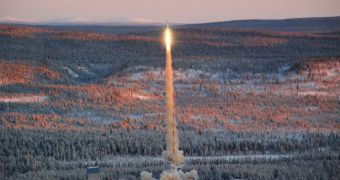On Sunday, November 27, the European Space Agency (ESA) and the German Aerospace Center (DLR) conducted a new rocket-based experiment in space, testing to see whether innovative, propellant-handling technologies they developed actually work in space.
Officials at both organizations say that the technologies would go on the next generation of rockets ESA will use to conduct both manned and robotic space exploration missions. The improved fuel management system was tested on a Texus delivery system.
The rocket was launched from the Esrange Space Center, near Kiruna, in northern Sweden, at around 1010 GMT. The flight – designated Texus 48 – saw the vehicle rise to an altitude of about 263 kilometers (163.4 miles). It lasted for only 13 minutes, of which 6 were spent in weightlessness.
However, this was more than enough for investigators to simulate various stages of spaceflight, as well as different approaches to use the test systems. Both devices are meant to store and handle liquid, ultra-cold hydrogen and oxygen fuels.
After the flight was concluded, they were recovered by ground teams, and returned to ESA for an in-depth analysis of their performances. This was the first Texus flight ever that was conducted in order to validate technologies for future ESA rockets.
The DLR was in charge of conducting the actual flight. It operated under the guises of the ESA Future Launchers Preparatory Program (FLPP) Cryogenic Upper Stage Technologies (CUST) project. One of its main goals is to create a restartable cryogenic upper stage.
Having this ability would significantly improve the functionality and expanded the uses of future ESA rockets. At this point however, handling propellants in space the way experts want it is possible only with conventional fuels.
What ESA wants is to be able to control propellants that are of extremely-high performance, such as liquid hydrogen and oxygen. The two devices aboard Texus 48 were developed for this specific purpose, and they behaved admirably.
“The launch of Texus 48 demonstrating new technologies for future rockets was a success. It also shows great cooperation with DLR, where joint efforts made this flight possible on time,” ESA FLPP program manager Guy Pilchen explains.
“On Texus 48, liquid nitrogen represented the cryogenic propellants to ease cost and safety constraints, and simplify the thermal design,” ESA says in a press release, noting that further tests of this type are pending.

 14 DAY TRIAL //
14 DAY TRIAL //